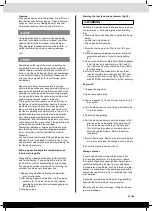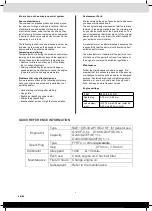
37 І 64
37 І 64
Draining the fuel tank and carburetor (Fig.18)
m
WARNING
Gasoline is highly flammable and explosive, and you
can be burned or seriously injured when handling
fuel.
•
Stop the engine and keep heat, sparks, and flame
away.
• Handle fuel only outdoors.
• Wipe up spills immediately.
1. Move the fuel valve lever (18a) to the OFF posi-
tion.
2. Place an approved gasoline container below the
carburetor, and use a funnel to avoid spilling
fuel.
3. Remove the carburetor drain bolt (18d) and gasket
(18e). Remove the sediment cup (18c) and O-
ring (18b) thenmove the fuel valve lever (18a) to
the ON position.
4.
After all the fuel has drained into the container,
reinstall the drain bolt (18d), gasket (18e), sedi-
ment cup (18c) and O-ring (18b). Tighten the
drain bolt (18d) and sediment cup (18c) securely.
Engine Oil
1. Change the engine oil.
2. Remove the spark plug.
3. Pour a teaspoon (5 10 cm) of clean engine oil into
the cylinder.
4.
Pull the starter rope several times to distribute the
oil in the cylinder.
5. Reinstall the spark plug.
6.
Pull the starter rope slowly until resistance is felt
and the notch on the starter pulley aligns with
the hole at the top of the recoil starter cover.
This will close the valves so moisture cannot
enter the engine cylinder. Return the starter
rope gently.
7. Electric starter type: Remove the battery and store
it in a cool, dry place. Recharge it once a month.
8. Cover the engine to keep out dust.
Storage precaut
If your engine will be stored with gasoline in the
fuel tank and carburetor, it is important to reduce
the hazard of gasoline vapor ignition. Select a well
ventilated storage area away from any appliance
that operates with a flame, such as a furnace, water
heater, or clothes dryer. Also avoid any area with a
sparkproducing electric motor, or where power tools
are operated.
If possible, avoid storage areas with high humidity,
because that promotes rust and corrosion.
Keep the engine level in storage. Tilting can cause
fuel or oil leakage.
Cleaning
If the engine has been running, allow it to cool for at
least half an hour before cleaning. Clean all exterior
surfaces, touch up any damaged paint, and coat
other areas that may rust with a light film of oil.
m
NOTE
Using a garden hose or pressure washing equip-
ment can force water into the air cleaner or muffler
opening.Water in the air cleaner will soak the air
filter, and water that passes through the air filter or
muffler can enter the cylinder, causing damage.
Fuel
m
NOTE
Depending on the region where you operate your
equipment, fuel formulations may deteriorate and
oxidize rapidly. Fuel deterioration and oxidation can
occur in as little as 30 days and may cause damage
to the carburetor and/or fuel system. Please check
with your servicing dealer for local storage recom-
mendations.
Gasoline will oxidize and deteriorate in storage.
Deteriorated gasoline will cause hard starting, and it
leaves gum deposits that clog the fuel system. If the
gasoline in your engine deteriorates during storage,
you may need to have the carburetor and other fuel
system components serviced or replaced.
The length of time that gasoline can be left in your
fuel tank and carburetor without causing functional
problems will vary with such factors as gasoline
blend, your storage temperatures, and whether the
fuel tank is partially or completely filled. The air in a
partially filled fuel tank promotes fuel deterioration.
Very warm storage temperatures accelerate fuel
deterioration. Fuel deterioration problems may occur
within a few months, or even less if the gasoline was
not fresh when you filled the fuel tank.
Fuel system damage or engine performance prob-
lems resulting from neglected storage preparation
are not covered under the Distributor’s Limited-
Warranty.
You can extend fuel storage life by adding a gasoline
stabilizer that is formulated for that purpose, or you
can avoid fuel deterioration problems by draining the
fuel tank and carburetor.
Adding a gasoline adjustment stabilizer to ex-
tend fuel storage life
When adding a gasoline stabilizer, fill the fuel tank
with fresh gasoline. If only partially filled, air in the
tank will promote fuel deterioration during storage.
If you keep a container of gasoline for refueling, be
sure that it contains only fresh gasoline.
1. Add gasoline stabilizer following the manufac-
turer’s instructions.
2. After adding a gasoline stabilizer, run the engine
outdoors for 10 inutes to be sure that treated
gasoline has replaced the untreated gasoline in
the carburetor
3. Stop the engine.
Summary of Contents for 160F
Page 3: ...3 І 64 1 1 2 3 4 5 6 7 8 10 11 12 13 12 13 9 6 2 7 ...
Page 27: ...27 І 64 27 І 64 ...
Page 45: ...45 І 64 45 І 64 ...
















































